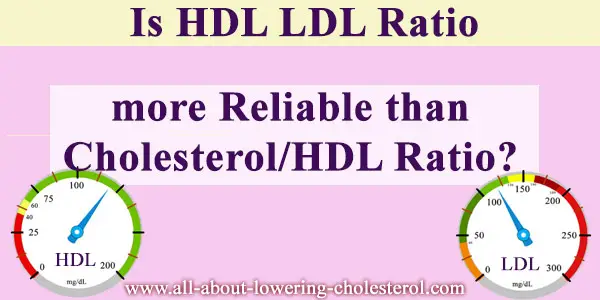
Is the Cholesterol HDL LDL ratio more reliable? Or total Cholesterol/HDL ratio? Find out why doctors order total cholesterol to HDL ratio testing?
The cholesterol HDL LDL ratio is more reliable when determining the real risk from high cholesterol than the total cholesterol HDL ratio.
The latter is a number that is obtained by dividing the total cholesterol value by the value of the HDL cholesterol. A higher ratio would mean that you have a higher risk of heart attacks and a lower ratio means a lower risk.
The cholesterol HDL LDL ratio is considered more reliable and accurate because LDL is an accurate measure of “bad cholesterol” and HDL is a good indicator of your “good cholesterol”.
The total cholesterol can be measured as:
Total Cholesterol = HDL + LDL + VDL
Even though total cholesterol to HDL ratio is not as pure or accurate when compared to cholesterol HDL LDL ratio, the former is more commonly used as it is easier and cheaper to obtain than cholesterol HDL LDL ratio.
However, Cholesterol to HDL ratio lacks one important key factor of LDL which is extremely important to estimate your “bad cholesterol”.
Your HDL cholesterol helps remove cholesterol from the body by transporting excess cholesterol to liver for its metabolism.
On the contrary, your LDL (low density lipoprotein) does not help you in such transportation of excess cholesterol rather it gets deposited on your blood vessels wall and leads to atherosclerosis (narrowing of arteries).
Therefore, it is important to measure LDL regardless of what is your total cholesterol to HDL ratio turned out to be. The Cholesterol HDL LDL ratio is determined by dividing the LDL cholesterol into your HDL cholesterol.
For example, if your HDL cholesterol is 50 mg/dL and your LDL cholesterol is 150 mg/dL, than the HDL/LDL ratio would be 0.33. The goal is to keep the ratio above 0.3, with the ideal HDL/LDL ratio being above 0.4.
It is interesting to note that scientists and doctors are divided over the effectiveness of Cholesterol HDL/LDL ratio to predict the chances of having heart attack.
To read a review about a cholesterol lowering supplement, click here.
Therefore, it is important to measure LDL regardless of what is your total cholesterol to HDL ratio turned out to be. The Cholesterol HDL LDL ratio is determined by dividing the LDL cholesterol into your HDL cholesterol.
For example, if your HDL cholesterol is 50 mg/dL and your LDL cholesterol is 150 mg/dL, than the HDL/LDL ratio would be 0.33. The goal is to keep the ratio above 0.3, with the ideal HDL/LDL ratio being above 0.4.
It is interesting to note that scientists and doctors are divided over the effectiveness of Cholesterol HDL/LDL ratio to predict the chances of having heart attack.
This is why total cholesterol and HDL ratio is commonly used in laboratory evaluation of cholesterol and HDL LDL ratio is ordered in those situations where more refined, accurate, and purer results pertaining cholesterol are required.
